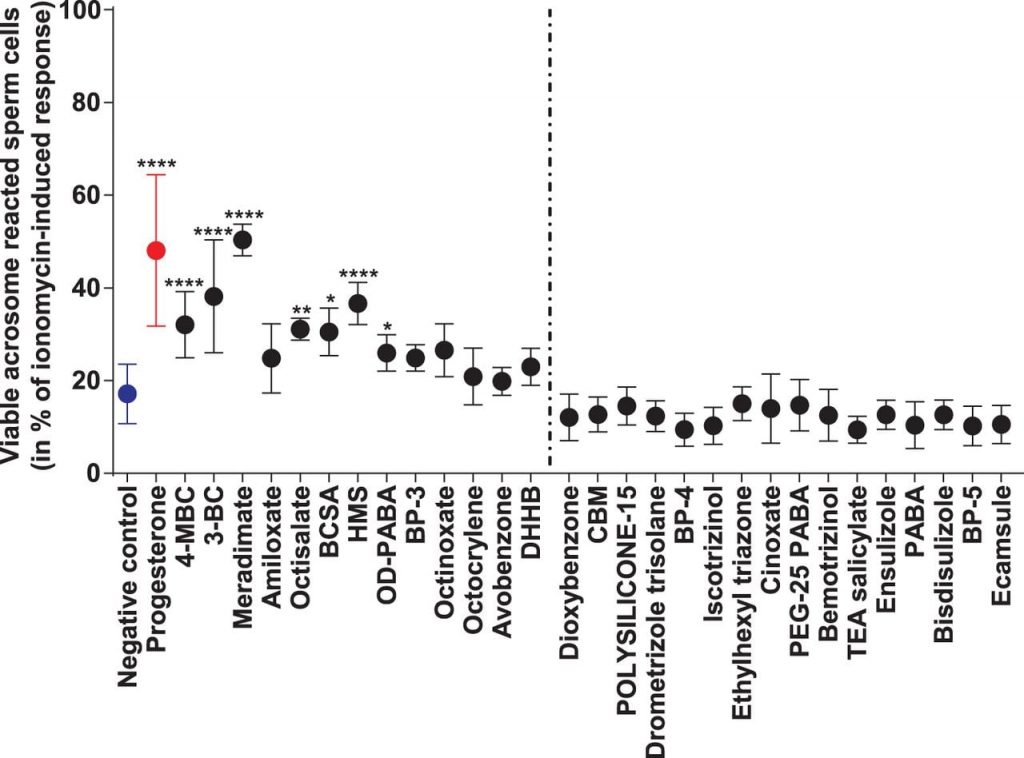
By Julia Beyer - August 8, 2018
In a study conducted at Copenhagen University it has been shown that 13 commonly used chemical UV-filters that are approved for use in sunscreens in the EU and/or the US may interfere with the function of human sperm cells. Two of the chemical sunscreen ingredients found to potentially decrease male fertility, Oxybenzone and Octinoxate, have already been banned by the state of Hawaii in June 2018 due to this and similar research indicating risks for humans and nature.

The effects of chemical UV-filters on sperm function
The researchers around the study’s senior investigator, Niels Skakkebaek, a professor at the University of Copenhagen and a researcher at the Copenhagen University Hospital, applied chemical UV-filters to live human sperm cells.
Four indicating factors of fertility were investigated: the percentage of healthy sperm cells (referred to as viability), the sperms’ ability to accelerate (hyperactivation), the reaction taking place when the sperm cell fuses with the female egg (acrosome reaction) and the ability of the sperms to reach the egg (penetration). Three of these factors, all except for hyperactivation, were shown to be affected by chemical UV-filters.
“This effect began at very low doses of the chemicals, below the levels of some UV filters found in people after whole-body application of sunscreens.”
– Professor Nils Skakkebaek who has been researching endocrine disrupting chemicals for more than 40 years
The most disconcerting result concerns the reaction usually taking place when a sperm cell fuses with the membrane surrounding the female egg (acrosome reaction). The researchers state that:
“This suggests that exposure to chemical UV filters could impair fertility by inducing premature acrosome reaction in human sperm cells.”
– Professor Nils Skakkebaek
Only sperm cells that have not undergone acrosome reaction can bind to the protective membrane surrounding the female egg. The following graph shows that the 13 UV-filters listed on the left prematurely induced this reaction, whereas the UV-filters to the right did not.

Only sperm cells that have not Imagine the sperm cells as fireworks that explode the second after you’ve fired them – you won’t see any effect in the sky where it actually matters. The same seems to happen when sperm cells get affected by chemical sunscreen filters like Avobenzone – they “fire” way before reaching the egg. In total, 13 out of 29 investigated chemical UV-filters were shown to potentially affect male fertility. These UV-filters were: Octisalate, Octinoxate, Octocrylene, Avobenzone, Amiloxate, Meradimate, DHHB, BCSA, HMS, OD-PABA, BP-3, 4-MBC and 3-BC. A list of all UV-filters and their full names can be found at the end of this article.ndergone acrosome reaction can bind to the protective membrane surrounding the female egg. The following graph shows that the 13 UV-filters listed on the left prematurely induced this reaction, whereas the UV-filters to the right did not.
In total, 13 out of 29 investigated chemical UV-filters were shown to potentially affect male fertility. These UV-filters were: Octisalate, Octinoxate, Octocrylene, Avobenzone, Amiloxate, Meradimate, DHHB, BCSA, HMS, OD-PABA, BP-3, 4-MBC and 3-BC. A list of all UV-filters and their full names can be found at the end of this article.
How chemical sunscreen ingredients affect sperm function
The UV-filtering ingredients tested in the study were shown to mimic the effect of progesterone, a hormone controlling sperm function during the fertilization process. Since the chemicals evoked reactions in the sperm cells “in a progesterone-like manner” this classifies them as endocrine disruptors.
Endocrine disrupting chemicals (EDCs) are substances in our environment, food, and personal care products that interfere with the human hormonal system and have been suspected to be an underlying cause of sperm dysfunction for some time.
“These results are of concern and might explain in part why unexplained infertility is so prevalent.”
– Professor Nils Skakkebaek
In line with these new results, studies on pregnant women have found that exposure to chemical UV-filters affects fetus development and traces of UV-filtering substances can be found in maternal urine as well as fetal and cord blood.

What now?
It has to be pointed out that while the study from Copenhagen University is alarming, further research like this study from Schiffer et al. is required to corrobate the findings. From what we know at the moment, choosing a non-nano mineral sunscreen (with a mineral UV-filter instead of a chemical UV-filter) is the safest alternative since they do not penetrate the skin and therefore imply less risk for humans.
UV-filters that were shown to potentially decrease male fertility by affecting acrosome reaction or penetration (all listed) or other factors related to male fertility (see in brackets)
BP-3 = Oxybenzone or benzophenone-3
Octisalate
Octinoxate
Octocrylene
Avobenzone (viability also affected)
Amiloxate
Meradimate
DHHB = Diethylamino hydroxybenzoyl hexyl benzoate
BCSA = Benzylidene camphor sulfonic acid
HMS = Homosalate
OD-PABA = Octyl-dimethyl-PABA or Padimate O
4-MBC = 4-Methylbenzylcathinone
3-BC = 3-Benzylidene camphor


